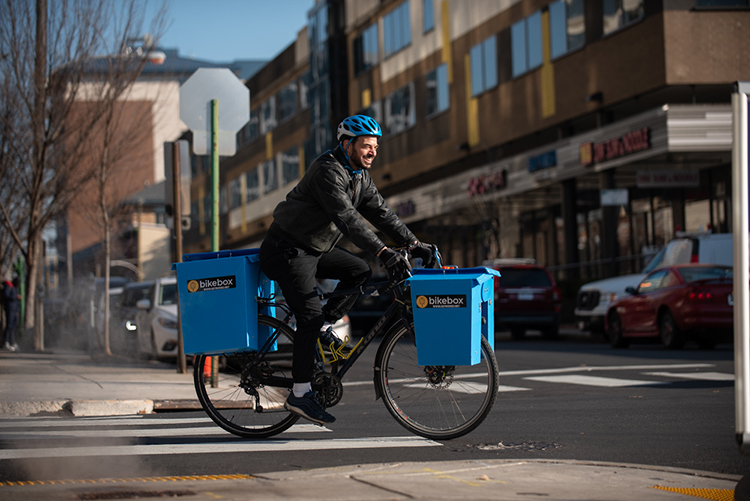By Emily Kovach
Nearly every cyclist has had this experience: You’re at the Reading Terminal or the farmers market to grab a few things. Five impulse buys later (beets were on sale!) and the ride home becomes a precarious one. Straining under a stuffed backpack, you swear you won’t make this mistake again.
And yet, you almost definitely will. That is, unless you’re one of the early adopters of the BikeBox. This ingenious bike-cargo solution is designed to take the load off your shoulders and put it onto the back of your bike. Designed to take the place of unbalanced panniers and flimsy milk crates, the BikeBox might be a key to unlocking the future of urban bike culture.
After researching and developing prototypes for a decade, Abraham Dubb, 47, a former primary-care physician, left a 15-year career in medicine to pursue this as a business.
“I am a diehard urban cyclist—I don’t currently own a car—and Philly’s geography and elevation make it one of the most bike-friendly towns around,” the Center City resident says. “I’ve always wanted to do things from my bike.”
Dubb is also a musician, and the BikeBox idea was born after many unsteady rides bringing his instruments and gear to shows. After trying a few different bike-mounted boxes, Dubb had a breakthrough in 2011: coroplast, the corrugated plastic that is used to make political-campaign signs.
“Corrugated plastic is a material of the future: It is very light, durable, waterproof, impact resistant and cushioned,” Dubb says. “Plus, it’s [made of] polypropylene, so it can be recycled and sourced from recycled materials.”
Working out of NextFab in South Philly, Dubb uses computer-aided design (CAD) software to develop the boxes virtually and then a Computer Numeric Control (CNC) cutter to finish them. One of the first BikeBox iterations (the BikeArrow, with boxes on the front and back of the bike) was field-tested by Dubb on a 550-mile bike ride between Philly and Charlottesville. Packed inside his BikeArrow was bottled water, a drone, his computer, two pairs of shoes, clothing, a tent and tools.
“It performed amazingly well,” he reports. “I rode through torrential downpours and on flooded paths, and everything was kept nice and dry.”
The BikeBox, which fits neatly over a standard rear rack on a bike, comes in two sizes: the Standard, a good size for groceries, and the smaller Bike Purse, with a more streamlined silhouette and a bit less cargo space. Both are available on BikeBox’s website and are assembled by the user at home. Dubb says he’s working on getting the BikeBox on the shelves of local bike shops, a goal for 2019.
He can also use his design and technology to make custom BikeBoxes, which opens up many possibilities.
“My vision is to revolutionize how we use our bikes,” Dubb says. “Couriers, food delivery services, bike touring…even in developing countries where people just don’t have cars, there are tons of DIY solutions, but it doesn’t seem like anyone’s found a large-scale solution.”
He envisions people and businesses getting creative with how to use the BikeBox, which can be branded, outfitted with speakers, GPS or other electronics, offering bike-based medical services or vending food.
One of the first local businesses Dubb has worked with is Jezabel’s, an Argentinian café, formerly located in Fitler Square, and now with a location at 45th and Walnut in University City. Owner Jezabel Careaga wanted to use her folding bike to make deliveries of her famous empanadas, especially on the UPenn campus.
“I’m a pretty environmental conscious person, and I thought, ‘How can we make this work without a car?’ ” she says. “[Dubb] custom-built a box that can fit ‘fish flats,’ a commonly used food tray in the restaurant industry, to fit on my foldable bike.”
Careaga, who met Dubb at NextFab, where she makes furniture, says the toughest ride she’s taken her BikeBox on was a trek to the Art Museum with 90 empanadas.
“The way that he builds them, the box is slightly U-shaped, so that helps with stability,” she says. “I think this is safer because you’re not carrying it on your body. It’s a lot less stress, and you can carry more food. It’s definitely an awesome product.”








